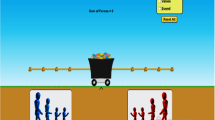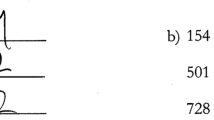Abstract
Biology knowledge and understanding is important not only for the conversion of the loftiest dreams into reality for a better life of individuals but also for preparing secondary pupils for such fields as agriculture, medicine, biotechnology, and genetic engineering. But a recent study has revealed that many aspects of school science (biology included) pose problems of understanding for pupils, simply because of the teaching methods used and the lack of adequate instructional resources. Nevertheless, a program was designed to incorporate the use of computer technology innovation called the computer-mediated simulations (CMS) program to enhance pupils' learning outcomes in school biology. The study was carried out in a real biology classroom setting. It involved comparisons between the treatment and control groups. A Solomon-Three Group quasi-experimental design was employed to involve three secondary schools situated along Njoro-Mau Narok and Elburgon-Molo roads in Nakuru district that were purposively sampled on the basis of easy accessibility and the availability of IBM compatible computers. A total of 102 pupils enrolled in three intact classes were exposed to the same content on cell division for a period of 3 weeks. Three dependent measures—the Biology Achievement Test (BAT), the Biology Classroom Environment Questionnaire (BCEQ), and the Pupil Attitude Questionnaire (PAQ)—were used to assess the effectiveness of the program on the pupils' academic achievement in cell theory, their perception of the classroom environment, and attitudes towards the biology course on cell theory. The findings of the study affirmed the impact of the CMS program on the pupils' learning outcomes in that the mean gains of the participants in the treatment groups were significantly higher than that of their counterparts in the regular program. Also, the results indicated that the mean differences between the experimental group and the true control group were statistically significant in favor of the treatment group. The findings also showed no relationship between the participants' gender and their learning outcomes. The study concludes that the use of the CMS program to augment conventional biology teaching has major implications for secondary biology instruction in this area.
Similar content being viewed by others
References
Allessi, S. M., and Trollip, S. R. (1991). Computer Based Instruction: Methods and Development, 2nd ed., Prentice-Hall, Englewood Cliffs, NJ.
Beichner, R. L. (1994). Multimedia editing to promote science learning. Journal of Educational Multimedia and Hypermedia 3: 55-70.
Brown, C. R. (1995). The Effective Teaching of Biology, Longman, New York.
Bude, U. (1995). Strategies for Using Information Technology to Improve Learning Conditions and Instructional Practices at the School Level, Permingomon Press, Bonn, Germany.
Fraenkel, J. R., and Warren, N. E. (1998). How to Design and Evaluate Research in Education, 2nd ed., McGraw-Hill, New York.
Kenya Institute of Education (1990). Formative evaluation of the secondary education curriculum. Research Report Series 22: 27.
Kenya Institute of Education (1992). Ministry of Education Secondary Education Syllabus, Vol. 7, Kenya Literature Bureau, Nairobi.
Kenya National Examination Council (2000). Examination report, Vol. 1. Kenya National Examination Council, Kenya.
Kiboss, J. K. (1997). Relative Effects of a Computer-Based Instruction in Physics on Students' Attitudes, Motivation and Understanding About Measurement and Perceptions of Classroom Environment, Doctoral Thesis, University of the Western Cape, South Africa.
Kiboss, J. K. (1999). Relative effects of a CBI in physics on students' achievement and attitudes towards the measurement lessons. Egerton University Journal of Science and Technology 2: 57-65.
Kiboss, J. K. (2000). Teacher/pupil perspectives on computer-augmented physics lessons on measurement in Kenyan secondary schools. Journal of Information Technology for Teacher Education 9: 199-218.
Kiboss, J. K. (2002). Impact of a CBI in physics on students' understanding of measurement concepts and skills associated with school science. Journal of Science Education and Technology 11: 193-198.
Lu, C., Voss, B., and Kleinsmith, L. (1997). The effects of a microcomputer-based biology study center on learning in high school biology students. The American Biology Teacher 59: 270-278.
Makau, B. M. (1990). Computers in Kenya's Secondary Schools, Case study of an innovation in education, International Development Research Centre (IDRC), Canada.
Makau, J. (1999, March 29). Computers in education. Daily Nation Newspaper p. 24.
Nancy, B. D., Pagogh, C., Guiticrez, J., Payne, C., Pruith, R., Wilcox, C., and Y Le Maistre, A. M. D. (1994). Interactive Computer Based Programs Versus Traditional Methods for Safety Study, Texas Medical School, University of Houston,Houston.
Ndirangu, M. (2000). A Study on the Perception of the Influence of Teaching Practice Projects on the Teaching of Science in Selected Secondary Schools in Kenya, Doctoral Thesis, Egerton University, Njoro, Kenya.
Njoo, M., and De Jong, T. (1993). Learning Process of Students Working With Computer Simulations in Mechanical Engineering, University of Eindhoven, Eindhoven, The Netherlands.
Ogunniyi, M. B. (1992). Understanding Research in Social Science, University Press Plc, Ibadan.
Okere, M. (1996). Physics Education: A Textbook of Methods for Physics Teachers, Egerton University Educational Materials Centre, Njoro, Kenya.
Oppenheimer, T. (1997). The computer delusion. The Atlantic Monthly 280: 45-62.
Republic of Kenya (1999). Totally Integrated Quality Education and Training, Government Printers, Nairobi.
Riddle, E. M. (1995). Communication through multimedia in an elementary classroom Report No. 143. University of Virginia, ERIC Documentation Reproduction Service ED384346, Charlottsville.
Wekesa, E. (2003). Effects of a Computer-Based Instruction Module on Students' Achievement, Perception of the Classroom Environment and Attitude Towards School Biology in Nakuru District, Kenya, Master's Thesis, Egerton University.
Author information
Authors and Affiliations
Corresponding author
Rights and permissions
About this article
Cite this article
Kiboss, J.K., Ndirangu, M. & Wekesa, E.W. Effectiveness of a Computer-Mediated Simulations Program in School Biology on Pupils' Learning Outcomes in Cell Theory. Journal of Science Education and Technology 13, 207–213 (2004). https://doi.org/10.1023/B:JOST.0000031259.76872.f1
Issue Date:
DOI: https://doi.org/10.1023/B:JOST.0000031259.76872.f1




